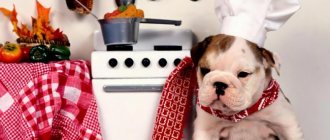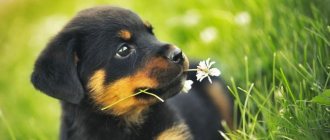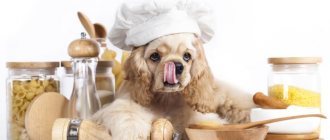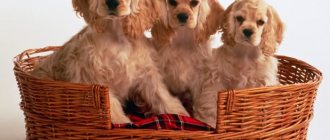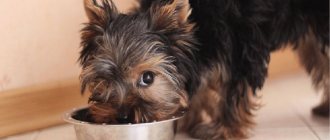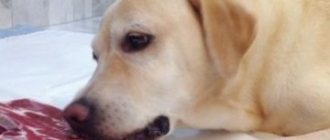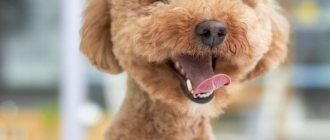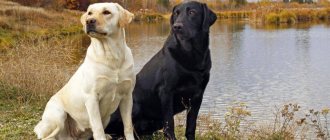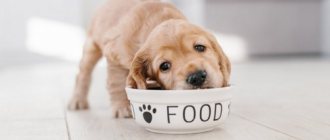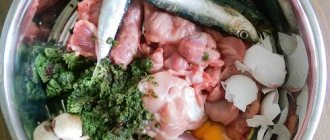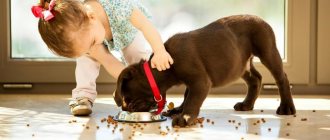The type of dog called retrievers combines six breeds. Among them there are very Popular breeds: golden retriever and labrador.
These animals are born hunters . They have an excellent sense of smell, a soft jaw and an easy-going nature. When hunting, they work in tandem with a cop: while the first detects the game, the second brings the shot prey to the owner without biting it.
In modern urban conditions, Labradors are kept at home not as hunter's assistants, but as pets. These are very kind dogs that love to play with children and can be just a good friend to anyone.
A feature of the breed is its tendency to gluttony - they are ready to eat any amount of food. This dog breed is also prone to obesity. Therefore, Labradors need long walks (in parks, squares, in the forest) and active games.
One of the most important elements of keeping any pet, especially such a large one, is nutrition .
To the question, what is the best food to feed a Labrador? The answer is clear - meat is the basis of any dog’s diet.
Important! Your Labrador needs to be fed regularly and at the same time. This will ensure balanced development along with the immediate composition of food.
What to feed a Labrador puppy at 1, 2, 3 months at home?
If a puppy appeared in your house immediately after weaning from its mother, then what should you feed your Labrador Retriever?
You can choose your own feeding option. At first, babies are fed liquid cereals and dry food, which is soaked in kefir or natural yogurt. But try not to keep your baby exclusively on dry food.
The puppy is given food in a bowl and removed after 15 minutes . If he didn't finish it, it was an excess of food.
There should be breaks between feedings - the puppy should not constantly run to the bowl in which food remains.
Advice! From the 5th week, puppies should be given finely chopped boiled meat (beef, lamb (without fat), veal). Until the age of 3 months, you cannot feed dry food, but you need to give special canned food if the diet does not include meat.
In addition, puppies are fed the following foods:
- fish (sea) – boiled and deboned;
- cereals – rice, buckwheat, oatmeal (with the addition of a few drops of vegetable oil);
- carrots, cabbage, zucchini, cucumbers, pumpkin, potatoes (raw, no more than 1 per week), turnips, beets (a little). All vegetables are grated.
- dairy products – kefir, natural yogurt, cottage cheese;
- 1 boiled egg per week or raw yolk;
- vitamins prescribed by a veterinarian.
- calcium, which can be given in the form of ready-made supplements or the shells can be dried in the oven, crushed and the resulting powder can be added to cereals and yogurt (kefir);
- finely chopped fresh herbs (lettuce, dill, parsley) - add to porridge;
- water – you need to refresh the water in the bowl throughout the day.
Rules of care
The daily routine of puppies at the age of 1 month is quite monotonous. They eat, relieve themselves, sleep, and play.
The puppy's place should be equipped taking into account these needs. You need a bed (bedding), a diaper, bowls for food and water, toys. There is no need to wash the puppy frequently unless necessary; this leads to degreasing of the coat, dry skin, and dandruff.
IMPORTANT!
It is necessary to arrange a safe place for the puppy so that he does not have access to electricity, household chemicals, or other dangerous things and substances!
For the safety and convenience of keeping your puppy, you can purchase a cage or enclosure. This keeps the apartment furnishings intact, makes toilet training easier, and the dogs perceive the crate as their place.
At 30 days, you need to start accustoming the puppy to a collar, toilet and diaper, you can start training (accustoming to a nickname, simple commands), teach behavior - in the house and with people.
All communication with a puppy at this age should be positive, without punishment. Often Labradors at this age bite their owners while playing - you need to carefully, without harshness, wean the puppy away from this - switch attention to the toy, ignore playing with the dog until it stops. When bitten, trainers advise sharply screaming and stopping the game to create a stable connection in the puppy - “bite-cry-end of the game.”
Teething causes itching, which puppies relieve by chewing. If you do not provide them with special toys and treats during this period, they may chew furniture, shoes, things and objects.
Once every 7-10 days you need to trim the puppy’s nails . It is more convenient to do this with a special nail clipper, which can be bought at a pet store. Be careful - you can only cut off the overgrown part of the claw, so as not to touch or damage the blood vessel.
How to properly feed a Labrador puppy at home from birth to one year?
After birth, the puppy must suckle from its mother for up to four weeks, as it is fully provided with all nutrients.
The puppy is 1-2 months , how many times a day should I feed my Labrador? He is fed 5-7 times a day . The amount of food per day is 300 - 350 grams .
At 3-4 months, food is reduced to 4-5 meals , the amount should be approximately 400 grams .
After turning 5 months old, how many times should you feed your Labrador puppy? A pet from five months to a year should be fed 3 times a day in the amount of 500 grams (remove second breakfast and afternoon snack, including this food in breakfast and dinner).
After a year - 2 times a day , and the amount is 1 kg of food.
Photos of puppies
The puppies walk quite actively, see well, and their ear canals open. By 1 month, the Labrador should already have a set of baby teeth - 6 incisors, 2 canines and four molars (2 each on the left and right) in the upper and lower jaw.
NOTE!
By 30 days of age, puppies weigh on average 3.5 kg, their height at the withers is about 23 cm.
What food should I feed my Labrador?
There are 3 feeding options for all dog breeds:
- Natural food – food is cooked or served raw. Includes different types of meat, fish, cereals, vegetables. It is important to provide such nutrition in the right proportions so that there is no deficiency or excess of vitamins . The disadvantage of this type of food is that it needs to be cooked often. Food should not be kept in the refrigerator for long. You should not give stale food.
- Dry food. Provide the dog with the necessary amount of calories and vitamins. This food is prescribed by a veterinarian.
Advice! If your Labrador eats mainly dry food, then you need to buy the highest quality brands and be sure to consult a doctor when choosing a brand of food. If an allergic reaction occurs (the dog itches, eyes water), then the retriever needs to be taken to the hospital, where a different food will be prescribed.
- Mixed food option - when the dog is given dry food, but natural food is used as additives and feeding. This food option is recommended by dog breeders. For example, give dry food in the morning, natural food in the evening.
Feeding a Labrador: why does a dog refuse food?
If your Labrador turns away from the bowl, don’t be immediately alarmed. The dog senses when it needs to have a small fasting day. However, you need to pay attention to it. The reasons for refusing to eat may be:
- pre-overeating;
- change of food or type of food;
- changes in the level of hormones in the blood (for example, during estrus or toxicosis during pregnancy);
- longing for loved ones and other stresses;
- improper behavior of the owner while eating the dog (rudeness and aggression).
When these psychological factors are eliminated, the dog will gradually calm down and begin to eat as before.
However, if appetite does not return and there is an increase in temperature. Or you see that the dog is constantly lying down, weak and lethargic. If your Labrador is vomiting, has diarrhea, or has unusual discharge (blood or pus), go to the vet immediately for an examination. The veterinarian will determine why the Labrador refuses to eat. Prescribe adequate treatment. Remember that if you have such symptoms, delay can end tragically.
How to properly feed a Labrador at home?
How to feed an adult Labrador, in its diet you need to adhere to the correct ratio of protein, fat and carbohydrates: 50% animal proteins, 30% complex carbohydrates (porridge) and 20% fruits and vegetables.
On average, what can you feed a Labrador per day: 400-450 grams. meat, 250-300 gr. porridge and 200 gr. vegetables and fruits. In total, approximately one kilogram of feed per day .
Depending on the weight of the Labrador, the dose increases or decreases.
Important! The dog should not be thin or fat - the sides should be rounded, the ribs should not be visible, but they can be felt. The coat is shiny and silky. If it is dull, then you should take it for a walk more often, feed your pet with vitamins A and E, and healthy treats you prepared with your own hands.
Feeding pregnant and lactating bitches
Pupping in Labrador bitches lasts about 2 months.
For the first half of the pregnancy, feed the pregnant dog unchanged (excess weight will complicate childbirth).
In the second , they increase the amount of meat (up to 1.5 kilograms per day or ~ 10-15% per week), vitamins and microelements (strictly observing the proportions) or simply switch to food for puppy bitches, the composition of which already takes into account the physiological state and needs animal in building material.
If the dog gets what it needs, then whelping and subsequent lactation will have little or no effect on its condition, coat quality and overall health.
If you switch the bitch to puppy food, there is no need to increase the portions or add vitamins and microelements. Feed your dog 6-8 hours after giving birth unless he asks sooner. With milk, a dog gives away 4-7% of its body weight every day. To ensure that the puppies grow up healthy and do not “drink” it, feed the bitch more often than usual (3-5 times) - the same as in the second half of pregnancy.
Remember about fresh water: it is needed for milk production. If the dog's diet is natural, its food should be liquid (thin porridge, meat soup, milk). Do not give potatoes: starch can clog the milk ducts.
A month to a month and a half after giving birth, gradually reduce the number of times the bitch feeds and the amount of water she drinks in order to smoothly complete the lactation period.
What should natural food include?
How to feed a Labrador natural food if the dog does not like raw meat? In this case, you need to give boiled or steamed meat. It is important and necessary to give stringy pieces of meat so that your pet chews them.
Offal must be cooked thoroughly and for a long time. The stomach (tripe) is given to the dog raw - it is very healthy and is a delicacy made from offal.
Natural food must be freshly prepared. It can be from the refrigerator (no more than two days) and heated.
Advice! You should not give your pets cold or hot food - only warm or room temperature.
If the dog categorically does not eat any of the food offered for several days, then you need to replace this product with an analogue, or prepare a treat with your own hands.
Food for Labrador, necessary products in the diet:
- meat (beef, veal, lamb (remove fat), horse meat, rabbit, turkey);
- liver, kidneys, heart, stomach;
- vegetables (carrots, pumpkin, cauliflower, beets, zucchini, turnips);
- 1 raw potato per week;
- fruits - apples, pears, apricots;
- fresh greens, spinach, lettuce, onions, garlic;
- dairy products (kefir, sour cream, cottage cheese, yogurt);
- vegetable oil (ordinary, flaxseed or olive);
- fish (sea, boiled, boned);
- cereals (buckwheat, rice, oatmeal);
- cartilaginous bones;
- eggs (once a week - in the form of an omelet or boiled);
- water (always keep it fresh).
Prohibited products:
- sausage, frankfurters;
- smoked, fried foods;
- sweet, salty, hot seasonings;
- pasta and legumes;
- lamb with fat, pork;
- bones – a dog may choke or swallow a sharp bone, causing intestinal ruptures;
- corn;
- milk (in adult dogs it causes diarrhea);
- baking (causes bloating).
Advice! The Labrador is a large dog, so you need to be careful what food you leave on the table unattended. Do not leave anything harmful or dangerous to your pet's health there.
Useful tips
Here's what you need to know about feeding Labradors:
- meals should be fractional;
- Snacks are prohibited for obese Labradors;
- food from the human table should not be freely available to the dog;
- You can’t mix drying and natural;
- It is forbidden to feed dogs hot food, food must be fresh but warm;
- you need to feed after walks;
- It is better to use special dishes that do not break and do not emit harmful substances.
For puppies, as well as for adult dogs, it is important to provide constant and unhindered access to clean water. This applies to both natural-fed puppies and those who are fed food.
Similar articles
Natural products
If a decision is made in favor of natural feeding, then the energy balance must be strictly observed. If a dog’s body experiences a deficiency in any resource, this can lead to a decrease in immunity and weight loss. The condition may worsen if there is an excess.
Raw meat must be present in your pet's diet.
Permitted and prohibited products
Until four weeks, puppies feed exclusively on their mother's milk. After this, you can already organize additional complementary feeding, but first you should figure out what you can feed a month-old Labrador.
The list of approved foods for Labradors includes:
- dietary meat, namely lean beef, rabbit, chicken;
- boiled offal;
- cereals - rice, oatmeal, buckwheat;
- fermented milk products;
- vegetables - carrots, pumpkin, cucumbers and zucchini;
- fruits, with the exception of apples and pears;
- greenery.
There are also forbidden foods that should never be included in the diet. It is imperative to exclude fatty meats and fish, and potatoes and cabbage from vegetables. You should also not give smoked, sweet or spicy foods.
Weekly menu for Labrador
Not everyone knows what to feed a Labrador at home, or what foods can be included in the animal’s diet. That’s why experienced dog handlers offer their own option:
- Monday - curd mass with low-fat sour cream and chopped vegetables in the morning, in the evening give rice cooked in meat broth with pieces of beef;
- Tuesday - in the morning, salad with egg yolks, pieces of cheese and raw beef, dinner consists of buckwheat with chicken breast and herbs;
- Wednesday - Monday menu;
- Thursday - Tuesday menu;
- Friday - pieces of vegetables and raw minced meat in the morning, in the evening you can give rice porridge with pieces of chicken fillet and herbs;
- Saturday - porridge cooked in water, vegetables and bifido in the morning, in the evening offer buckwheat with beef and herbs;
- Sunday - in the morning give porridge with the addition of crackers and herbs, cottage cheese, in the evening - boiled offal and rice.
Important! Adult pets should receive meat daily; this is important for the health and activity of the retriever. Prohibited foods include chocolate, lemons and garlic and onions.
Choose a diet suitable for the predator
Externally, all dry food is similar to each other, but their composition can differ significantly. When choosing food for a puppy, we must not forget that we are planning to feed a predator, albeit a small one. In the wild, canids feed primarily on large and small animals. In summer, they do not miss the opportunity to eat a clutch of eggs or chicks from a randomly found nest.
Wild dogs pay less attention to plant foods; in the summer they sometimes supplement their diet with berries, fruits and even mushrooms
The diet of a domestic predator should look similar. However, if you look at the list of ingredients of many dog foods, you will find wheat, rice and other grains in the first positions. Meat is added to such products, as they say, for flavor and can be of extremely low quality. And to bring the overall percentage of protein up to the industry standard, plant protein sources are used. On such a diet, a puppy is not able to obtain the entire spectrum of necessary amino acids, which is why it can grow weak and loose.
Acana and Orijen dry dog foods are created according to the principle of biological matching. They consist of the same products that canine predators eat in their natural habitat: meat and entrails of herbivores, poultry, eggs, a small amount of animal fats and plant components. Some lines of Acana and Orijen food have specialized diets for puppies: they are slightly higher in calories, high in animal protein and fat. However, any of the dry dog food presented on our website can be used to feed puppies: the only difference will be in the feeding rates.
Reproduction
The first thing you must understand and learn: only breeding representatives of the breed can participate in breeding, in accordance with the breeding plan drawn up in the kennel club. If you have purchased a pet-class dog, it is better to sterilize it immediately
The common belief that a dog needs to be mated at least once in its life “for health” is a harmful myth. Having untied the male, you will have to provide him with regular matings, and this is reasonable only if the male is good enough in terms of breed. A castrated male does not suffer at all from the absence of testicles; he retains a lively and energetic character and mobility. But he does not suffer from hormonal storms when a female dog in heat appears in the area, is free from the associated stress and lives longer. Males are sterilized after reaching physiological maturity.
A spayed female dog is guaranteed not to breed accidentally and will also not develop pyometra or ovarian cancer. The absence of heat will make the dog calmer and your apartment cleaner, since the heat of this breed can be quite abundant and leaves marks throughout the house. Sterilization, like mating in Labradors, occurs after 2 years, when the dog’s body is already fully formed.
If your bitch belongs to the breeding class, and you intend to breed her in order to produce puppies, then be prepared for the subsequent renovation of the apartment. Labrador retrievers usually give birth to 5 to 10 puppies, and these little terminators can turn the most well-kept apartment into something completely obscene.
The first heat in Labrador bitches occurs at the age of 8 months to one and a half years, but mating is carried out only at 2-4 heats. During this time, you will already have time to decide whether to breed or sterilize the dog.
Which food is better, raw or boiled?
The question of what to feed your Labrador - raw or cooked foods - is very controversial. On the one hand, raw foods contain more useful elements, but still greater preference is given to cooked foods.
Proper heat treatment allows you to destroy pathogens that are often found in products, as well as worm eggs. During cooking, plant fiber becomes softer and is better absorbed by the animal’s digestive system. If you use gentle methods, such as steaming, you can preserve vitamins as much as possible.
Meat can be given raw, but first freeze it.
In some cases, veterinarians recommend eating raw foods, but this is only under certain circumstances and following expert advice.
